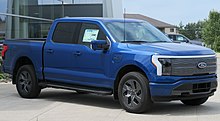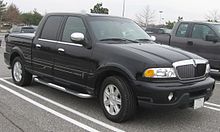Pickup truck




A pickup truck is a type of vehicle designed to move things. It is an all-purpose vehicle generally used for the transport of goods. They have an uncovered rear (called a box, boat, raft, bucket, body, plate, bed or basin). It is a cargo area for products or objects. The style is common in North America. Pickup truck cabs have options that can make them as comfortable to drive as a car.
History
In the early days of automobile manufacturing, vehicles were sold as a chassis only, and third parties added bodies on top.[1] In 1902, the Rapid Motor Vehicle Company was founded by Max Grabowsky and Morris Grabowsky who built one-ton carrying capacity trucks in Pontiac, Michigan. In 1913, the Galion Allsteel Body Company, an early developer of the pickup and dump truck, built and installed hauling boxes on slightly modified Ford Model T chassis,[2] and from 1917 on the Model TT. Seeking part of this market share, Dodge introduced a 3/4-ton pickup with cab and body constructed entirely of wood in 1924.[3] In 1925, Ford followed up with a Model T-based, steel-bodied, half-ton with an adjustable tailgate and heavy-duty rear springs.[4] Billed as the "Ford Model T Runabout with Pickup Body", it sold for US$281; 34,000 were built. In 1928, it was replaced by the Model A, which had a closed-cab, safety-glass windshield, roll-up side windows, and three-speed transmission.
In 1931, GM introduced light-duty pickups for both GMC and Chevrolet targeted at private ownership. These pickup trucks were based on the Chevrolet Master. In 1940, GM introduced the dedicated light-truck platform, separate from passenger cars, which GM named the AK series.[5] Ford North America continued to offer a pickup body style on the Ford Model 51, and the Ford Australian division produced the first Australian "ute" in 1932.[6] In 1940, Ford offered a dedicated light-duty truck platform called the Ford F100, then upgraded the platform after World War II to the Ford F-Series in 1948.
Dodge at first assumed heavier truck production from Graham-Paige, while the company produced their own light (pickup) trucks, initially on their sufficiently sturdy passenger car frames. But after switching to distinct, dedicated truck frames in 1936, Dodge/Fargo launched an extensive own truck range for 1939, marketed as the 'Job-Rated' trucks. These Art-Deco styled trucks were again continued after WW II.
International Harvester offered the International K and KB series, which were marketed towards construction and farming and did not have a strong retail consumer presence, and Studebaker also manufactured the M-series truck. At the beginning of World War II, the United States government halted the production of privately owned pickup trucks, and all American manufacturers built heavy duty trucks for the war effort.[5]
In the 1950s, consumers began purchasing pickups for lifestyle rather than utilitarian reasons.[5] Car-like, smooth-sided, fenderless trucks were introduced, such as the Chevrolet Fleetside, the Chevrolet El Camino, the Dodge Sweptline, and in 1957, Ford's purpose-built Styleside. Pickups began to feature comfort items such as power options and air conditioning.[1] During this time, pickups with four doors, known as a crew cab, started to become popular. These pickup trucks were released in 1954 in Japan with the Toyota Stout,[7][8] in 1957 in Japan with the Datsun 220, and in 1957 in America with the International Travelette.[9] Other manufactures soon followed, including the Hino Briska in 1962, Dodge in 1963,[10] Ford in 1965, and General Motors in 1973.[11]
In 1963, the U.S. chicken tax directly curtailed the import of the Volkswagen Type 2, distorting the market in favor of U.S. manufacturers.[12] The tariff directly affected any country seeking to bring light trucks into the United States and effectively "squeezed smaller Asian truck companies out of the American pickup market."[13] Over the intervening years, Detroit lobbied to protect the light-truck tariff,[12] thereby reducing pressure on Detroit to introduce vehicles that polluted less and that offered increased fuel economy.[12]
The U.S. government's 1973 Corporate Average Fuel Economy (CAFE) policy set higher fuel-economy requirements for cars than pickups. CAFE led to the replacement of the station wagon by the minivan, the latter of which belonged in the truck category, which allowed it compliance with less strict emissions standards. Eventually, CAFE led to the promotion of sport utility vehicles (SUVs).[14][15] Pickups, unhindered by the emissions controls regulations on cars, began to replace muscle cars as the performance vehicle of choice. The Dodge Warlock appeared in Dodge's "adult toys" line,[1] along with the Macho Power Wagon and Street Van. The 1978 gas guzzler tax, which taxed fuel-inefficient cars while exempting pickup trucks, further distorted the market in favor of pickups. Furthermore, until 1999, light trucks were not required to meet the same safety standards as cars[16] and 20 years later most still lagged behind cars in the adoption of safety features.[17]
In the 1980s, the compact Mazda B-series, Isuzu Faster, and Mitsubishi Forte appeared. Subsequently, U.S. manufacturers built their own compact pickups for the domestic market, including the Ford Ranger, and the Chevrolet S-10. Minivans make inroads into the pickups' market share.[1] In the 1990s, pickups' market share was further eroded by the popularity of SUVs.[1]
Mid-sized electric trucks had been tried early in the 20th century[18] but soon lost out to gasoline and diesel vehicles. In 1997 the Chevrolet S-10 EV was released, but few were sold, and those were mostly to fleet operators.[19]
By 2023, pickup trucks had become strictly more lifestyle than utilitarian vehicles. Annual surveys of Ford F-150 owners from 2012 to 2021 revealed that 87% of the owners used their trucks frequently for shopping and running errands and 70% for pleasure driving, whereas 28% used their trucks often for personal hauling (41% occasionally and 32% rarely/never) and only 7% used them for towing while 29% only did so occasionally and 63% rarely/never did. A 1960s-1970s Ford F-100 was typically regular cab and consisted of mostly 64% bed and 36% cab, while by mid-2000s, crew cabs were largely becoming the norm and the bed was shrunk to accommodate the larger cab, and a 2023 F-150 consisted of 63% cab and 37% bed.[20]
Form
The back of the truck is open, like some other types of trucks. It is very powerful for its small size. Pickup trucks have different shapes, sizes, and uses. Sometimes people would go ride in the back of the trucks to work. The back of the truck where the goods are placed is called a cargo bed. The cargo bed may be covered with a tonneau cover made of cloth, metal or plastic, to protect the cargo from rain and dirt.
Pickup trucks are easy to load and unload. They are especially popular in the countryside, where they are used to carry various agricultural cargo or tools.
Pickup trucks often have the same chassis as vans. Usually, pickup trucks are same size as normal cars. You usually may drive a pickup truck with the same driver's license as an ordinary car, but heavy pickup trucks may require a light truck license. The smallest pickup trucks are made from scooters by replacing the rear seat and rear wheel with an axle and cargo bed, and some have only three wheels.
A pickup truck can be turned into an improvised military vehicle by installing a machine gun or a light cannon on the cargo bed. Such cars are called "technicals", and they are especially popular in Africa. Pickup trucks are considered one of the most reliable and popular cars in the U.S. It is because of their functionality and good fit to the climate or landscape.
Related pages
References
- ↑ 1.0 1.1 1.2 1.3 1.4 Mueller, Mike (1999). The American Pickup Truck. p. 9. ISBN 9780760304730.
- ↑ "Encyclopedia of American Coachbuilders & Coachbuilding". Coachbuilt. Retrieved 10 April 2012.
- ↑ "1918 to 1928 Dodge Brother Pickups". Archived from the original on 8 March 2019. Retrieved 26 May 2015.
- ↑ "The History of Ford Pickups: The Model T Years 1925–1927". PickupTrucks.com. Archived from the original on 30 November 2010. Retrieved 4 June 2009.
- ↑ 5.0 5.1 5.2 "Trucking Timeline: Vintage and Antique Truck Guide". Retrieved 26 May 2015.
- ↑ "Australia Innovates: The Ute: 1934 vehicle with car cabin and utility tray". Powerhouse Museum. Retrieved 4 October 2021.
- ↑ "Toyota Vehicle Identification Manual", Toyota Motor Corporation, Overseas Parts Department, Catalog No.97913-84, 1984, Japan
- ↑ "Toyota Truck 48HP". brochure No. 228. Japan: Toyota. 1954. Archived from the original on 14 March 2012. Retrieved 17 June 2011.
- ↑ "The Evolution Of The Great American Pickup Truck, From 1925 To Today". Daily Detroit. 22 April 2017. Archived from the original on 13 November 2020. Retrieved 13 November 2020.
- ↑ "Ram history page on Allpar". Retrieved 4 June 2007.
- ↑ "Chevrolet Avalanche press release" (Press release). Archived from the original on 14 June 2007. Retrieved 4 June 2007.
- ↑ 12.0 12.1 12.2 Bradsher, Keith (30 November 1997). "Light Trucks Increase Profits But Foul Air More than Cars". The New York Times. Retrieved 28 April 2010.
- ↑ Hunting, Benjamin (10 March 2009). "Global Vehicles and Thailand Argue Against 'Chicken Tax' On Imported Pickups". Autobytel.
- ↑ Brown, Warren (13 April 2007). "Greenhouse Real Wheels". The Washington Post. Retrieved 22 June 2007.
- ↑ Brown, Warren (29 August 2004). "The Station Wagon Stealthily Returns". The Washington Post. Retrieved 22 June 2007.
- ↑ Eddington, Julia (16 July 2015). "Why Trucks Aren't as Safe as Cars". The Zebra. Retrieved 29 October 2019.
- ↑ Atiyeh, Clifford (21 March 2019). "Three Pickup Trucks Ace IIHS Crash Tests, Yet Many Aren't As Safe As They Should Be". Car and Driver. Retrieved 29 October 2019.
- ↑ "Electric truck". Autocar. US. 14 June 1923. Retrieved 1 October 2022.
- ↑ Stumpf, Rob (13 December 2019). "Forget the Cybertruck: Get Yourself a Factory 1997 Chevrolet S-10 Electric Pickup". The Drive. Retrieved 1 October 2022.
- ↑ "Pickup trucks have gotten bigger, higher-tech — and more dangerous". www.axios.com. Retrieved 2023-02-02.
Other websites
![]() Media related to Pickup trucks at Wikimedia Commons
Media related to Pickup trucks at Wikimedia Commons